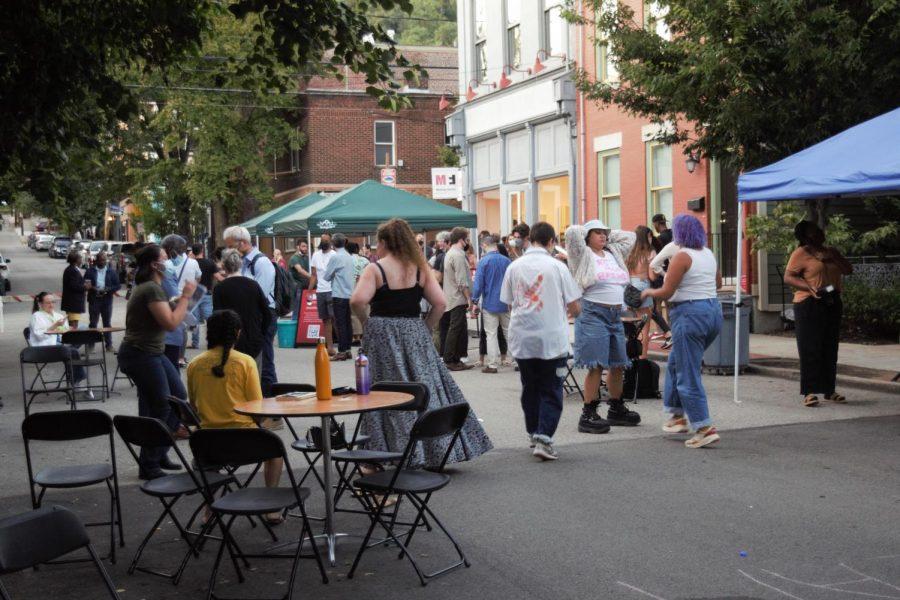‘Making home here’ exhibit debuts quarantine inspired art at The Mattress Factory
Clare Sheedy | Senior Staff Photographer
“Making home here” debuted on Thursday night with a free community block party, which included games of hopscotch, jump rope, a DJ and vegan food trucks.
September 3, 2021
Many people spent the majority of their time last year in their homes, just trying to get through each day as it came. But for the five local artists featured in The Mattress Factory’s newest exhibition, “making home here,” their homes came to life through the art they made while in quarantine.
“Making home here” curator Sean Beauford said the concept for the exhibition came to fruition in the start of the COVID-19 pandemic, when the exhibit curators were having a conversation with various artists on Zoom about what they were working on during lockdown.
“Everyone kind of noticed that a lot of people were making things that had to do with home already in some way,” Beauford said. “We met on Zoom, so we were really conscious of that — it’s like no one sees your home but still, your home is in the background in front of everybody.”
“Making home here” is this year’s first in-person exhibition at The Mattress Factory, centering on themes of equity in the arts. The display debuted on Thursday night with a free community block party, which included games of hopscotch, jump rope, a DJ and vegan food trucks. The exhibit will run until late spring 2022.
Beauford maintains a strong relationship with The Mattress Factory. Since 2017, he has curated art projects in multiple Pittsburgh museums such as The Andy Warhol Museum and the Carnegie Museum of Art. He said “making home here” was his first exhibit opening since the pandemic.
“One of the things we were really mindful of when thinking of people seeing this in person is that they are able to engage with it,” Beauford said. “There were a lot of online exhibitions, but there’s something amazing about being able to see art in a physical space again.”
One featured artist who particularly embraced audience engagement is Hill District resident Naomi Chambers, whose piece was a room designed to explore Black survival in the United States.
The room was filled with remnants of a Black community’s ice cream social, tea party and old-fashioned cinema. Chambers encouraged attendees to contribute to her part of the exhibit by inviting them to put stickers on the wall. When examining the needs of Pittsburgh’s Black community, Chambers said she thought one of the things the community needs most is joy.
“One of the things I always wanted to do as a kid was to sticker the walls,” Chambers said. “I figured out that a low stakes, fun way for people to get involved is stickers 一 to add to the joy and to the fun.”
Chambers said she started to think deeply about Black survival in America back in 2016, when she joined a community group centered on the fundamental needs of the Black community of Pittsburgh. Her piece came to fruition when she researched a Black Community Survival Conference that took place in the ‘70s. Her art piece was created to modernize that conference.
“[The conference] held different events 一 sickle cell anemia testing, voter registration 一 different things that the Black community needed at the time,” Chambers said. “And so, this is my conference 一 a tea party, ice cream social and cinema 一 things that would bring us rest.”
Chambers, a Pitt alumna, started out as an undecided major in the early 2000s and started taking art classes. Since then, she said she has embraced her outlandish ideas and turned them into thought-provoking art.
“I had such a supportive group of artists at Pitt,” Chambers said. “I fell in love with the purpose of art.”
Another Pittsburgh native, artist Justin Emmanuel Dumas, presented a piece made entirely of reclaimed architectural fragments such as railings, banisters, columns and window shutters. He said he aimed to tell a story through his architecture.
“You can really read the surfaces around you and think there’s a narrative present in spaces with enough history,” Dumas said. “For this show, I was thinking about the perimeter between what is personal space and what is public space.”
In Dumas’ room in the exhibit, there is a door’s threshold in the middle of the space, which he said he sees as the dividing line between personal and public space. Over the threshold is an archway which is made out of ballistic gel. Dumas said he wanted the archway not to be seen as an object that divides, but a membrane for the guest to pass through.
“I really wanted to play on this tension of uncertainty about the future, but then also this call to adventure 一 the desire to leave home and gather experiences and come back to that personal space,” Dumas said. “The movement through the room is moving out of your comfort zone and coming back and bringing more than you left with back to that personal space.”
Beauford said that, above all, he was glad that “making home here” achieved reimagining The Mattress Factory as a domestic space.
“I’m really proud of the artists for pushing themselves and producing truly thoughtful work,” Beauford said. “I’m also proud that the museum and the community was open to anything to support this project.”








